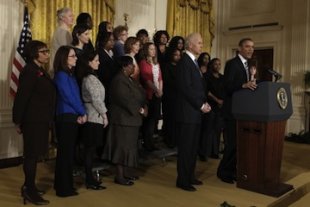NEW YORK (AP) ? They stream in a couple of dozen times a week, cries for help in bursts of text to DoSomething.org, a nonprofit more used to texting out details to teens on good causes and campaigns than receiving them from young people in crisis.
"I feel like committing suicide," one text read. "What's the suicide hotline number?" Another asked: "How do you tell a friend they need to go to rehab?"
DoSomething isn't a hotline, but its CEO, Nancy Lublin, decided to, well, do something. She's leading an effort to establish a 24/7 national text number across trigger issues for teens in the hope that it will become their 911, perhaps reaching those who wouldn't otherwise seek help using more established methods of telephone talking or computer-based chat.
"Most of the texts we get like this are about things like being bullied," Lublin said. "A lot of things are about relationships, so we'll get texts from kids about breakups, or 'I like a boy, what should I do?' But the worst one we ever got said, 'He won't stop raping me. It's my dad. He told me not to tell anyone. Are you there?'"
Lublin hopes the Crisis Text Line, due to launch in August, will serve as a New York-based umbrella, shuttling texts for help to partner organizations around the country, such as The Trevor Project for gay, lesbian, bisexual and questioning youth or other groups already providing hotlines on dating and sexual abuse to bullying, depression and eating disorders.
As more teens have gone mobile, using their phones as an extension of themselves, hotline providers have tried to keep up. Fewer seem to operate today than in decades past. A smattering reach out through mobile text, including Teen Line in Los Angeles, though that service and others offer limited schedules or are "siloed," as Lublin put it, specializing in narrow areas of concern when multiple problems might be driving a teen to the brink.
Some text providers operate in specific towns, counties or regions and-or rely on trained teen volunteers to handle the load across modes of communication. Several agreed that text enhances call-in and chat options for a generation of young people who prefer to communicate by typing on their phones, especially when they don't want parents, teachers, friends or boyfriends to listen in.
"We've had people who are walking and they just needed to get out of their house because they had an argument with their parent, so they're texting us as they're calming down," said Jennifer James, who supervises chat and text outreach for Common Ground, which also serves adults from its base in southeastern Michigan.
Katie Locke, 26, in Philadelphia was one of those teens in 2006, when she found herself in a suicidal panic after a fight with an old friend.
At 18, she said she grabbed her phone, left her college dorm room and headed out in the cold to sit on a bench to talk with a worker on a crisis phone line she knew from one of her favorite blogs. The number was the only one she had handy and it didn't offer text, which she would have preferred.
"People don't always have the (mobile phone) minutes or aren't in a position where they can speak aloud if they're in danger from somebody around them," Locke said. "I know for me there were other times when I probably should have called a crisis hotline and didn't because of the anxiety about calling. That was such an enormous barrier, to have to dial a phone number."
Brian Pinero, director of the National Dating Abuse Helpline run by a nonprofit called Love is Respect, knows that lesson well.
The organization launched phone and computer-based chat in 2007, and chat quickly grew to the more heavily used method of contact. The Austin, Texas-based group launched text in 2011 and it's now about 20 percent of the operation, Pinero said.
"Many times the phone is actually the most powerful computer in the home, but also for people who are of lower socio-economic status, they may not have the ability to engage in chat. Text messaging is something that is even offered on pay-as-you-go phones."
According to research from the Pew Internet & American Life Project, one in four teens is a "cell-mostly" Internet user. Texting among teens increased from about 50 texts a day in 2009 to about 60, with the number running into hundreds for some.
"Phone calls are not the way young people express themselves," said Danah Boyd, a senior researcher at Microsoft Research and an assistant professor of media, culture and communication at New York University.
"And one of the big problems that's emerged is hotlines are splintered across a ton of different phone numbers. Young people don't know them," said Boyd, who sits on the board of Crisis Text Line.
Comparisons of text hotline volume and efficiency are hard to come by. Researcher Deb Levine, executive director and founder of the nonprofit ISIS, for Internet Sexuality Information Services, said it's clear the number of hotlines of all kinds has declined significantly since a heyday in the Just Say No 1980s.
But chat and text help have been on the rise for more than two years, she said. Most are small-scale operations serving specific communities, said Levine, who lives in the San Francisco Bay area.
"Hotlines are always going to serve a purpose for some teens. Some of them are going to pick up the phone and call, some of them are going to text. I do believe that there's only so much you can do in 160 characters," she said. "There is a power to voice."
The Planned Parenthood Federation of America is in its second year of running one of the largest text and chat outreach operations for people ages 15 to 24, targeting African-American and Latino youth through promotional campaigns on MTV, websites and mobile providers, social media, wallet cards, video and Seventeen magazine.
Through February, nearly 185,000 conversations ? 22,447 via text ? were recorded, according to Planned Parenthood. About a third of conversations on health-related topics ? including birth control, abortion and pregnancy tests ? were with users both under 25 and African-American or Latino.
And nearly all chat and text users ages 15 to 24 agreed or strongly agreed that they were satisfied with their conversations, indicating significantly decreased levels of worry afterward.
"What we've seen from our online chat and text-messaging program is that they appreciate a real answer, in real time, from a real person," said Leslie Kantor, Planned Parenthood's vice president of education.
Evie Priestman, 14, an eighth-grader in Arlington, Va., has called hotlines as recently as a month ago, when she reached out for information on fending off suicidal thoughts, but she hasn't tried text.
"I think teens would definitely use a hotline if they could text to it. I know I would," she said. "Most teens keep their feelings to themselves."
Debbie Gant-Reed sees the need every day. She's the crisis lines coordinator at a 24-hour help line in Reno, Nev., called the Crisis Call Center. The center has been providing 24-hour text help for two and a half years, fielding about 500 text conversations a month.
"We're now taking texts from all over the country," she said. "You can chat all you want but you're going to get older people. Young people don't chat. They text."
___
Follow Leanne Italie on Twitter at http://twitter.com/litalie
___
Online:
http://www.crisistextline.org/ (text service scheduled to launch in August)
Planned Parenthood Federal of America text line video: http://www.youtube.com/watch?v=qYj4TF4c42Y (text PPGO to 774636)
National Dating Abuse Helpline: http://www.loveisrespect.org/about-national-dating-abuse-helpline
National Suicide Prevention Lifeline: http://www.suicidepreventionlifeline.org/ (phone and chat service only)
Crisis Call Center: http://www.crisiscallcenter.org/crisisservices.html (text ANSWER to 839863)
Teenlineonline.org: Teen Line in Los Angeles (text TEEN to 839863)
Source: http://news.yahoo.com/crisis-hotlines-turning-text-reach-teens-160806045.html
fat tuesday ash wednesday kate middleton marco rubio marco rubio Zero Hour Funny Valentines
 R2D2 greets the crowd at this year's WonderconANAHEIM, CA - The power of the Force may be elusive outside the fictional Star Wars universe but fans of R2D2 can take home their very own astromech droid if they have the time and money to build it.
R2D2 greets the crowd at this year's WonderconANAHEIM, CA - The power of the Force may be elusive outside the fictional Star Wars universe but fans of R2D2 can take home their very own astromech droid if they have the time and money to build it.

 While I think it's safe to assume that the average Lifehacker reader knows their Wi-Fi password off the top of their head, the same can probably not be said for most of our friends and family members.
While I think it's safe to assume that the average Lifehacker reader knows their Wi-Fi password off the top of their head, the same can probably not be said for most of our friends and family members. Stacked CDs
Stacked CDs 

